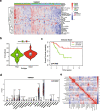The tumor immune microenvironment and immune-related signature predict the chemotherapy response in patients with osteosarcoma
- PMID: 34016089
- PMCID: PMC8138974
- DOI: 10.1186/s12885-021-08328-z
The tumor immune microenvironment and immune-related signature predict the chemotherapy response in patients with osteosarcoma
Abstract
Background: Genome-wide expression profiles have been shown to predict the response to chemotherapy. The purpose of this study was to develop a novel predictive signature for chemotherapy in patients with osteosarcoma.
Methods: We analysed the relevance of immune cell infiltration and gene expression profiles of the tumor samples of good responders with those of poor responders from the TARGET and GEO databases. Immune cell infiltration was evaluated using a single-sample gene set enrichment analysis (ssGSEA) and the CIBERSORT algorithm between good and poor chemotherapy responders. Differentially expressed genes were identified based on the chemotherapy response. LASSO regression and binary logistic regression analyses were applied to select the differentially expressed immune-related genes (IRGs) and developed a predictive signature in the training cohort. A receiver operating characteristic (ROC) curve analysis was employed to assess and validate the predictive accuracy of the predictive signature in the validation cohort.
Results: The analysis of immune infiltration showed a positive relationship between high-level immune infiltration and good responders, and T follicular helper cells and CD8 T cells were significantly more abundant in good responders with osteosarcoma. Two hundred eighteen differentially expressed genes were detected between good and poor responders, and a five IRGs panel comprising TNFRSF9, CD70, EGFR, PDGFD and S100A6 was determined to show predictive power for the chemotherapy response. A chemotherapy-associated predictive signature was developed based on these five IRGs. The accuracy of the predictive signature was 0.832 for the training cohort and 0.720 for the validation cohort according to ROC analysis.
Conclusions: The novel predictive signature constructed with five IRGs can be effectively utilized to predict chemotherapy responsiveness and help improve the efficacy of chemotherapy in patients with osteosarcoma.
Keywords: Chemotherapy; Immune-related gene; Osteosarcoma; Predictive signature; Tumor immune microenvironment.
Conflict of interest statement
The authors declare that they have no competing interests.
Figures






Similar articles
-
Profiles of immune cell infiltration and immune-related genes in the tumor microenvironment of osteosarcoma cancer.BMC Cancer. 2021 Dec 18;21(1):1345. doi: 10.1186/s12885-021-09042-6. BMC Cancer. 2021. PMID: 34922489 Free PMC article.
-
A prognostic glycolysis-related gene signature in osteosarcoma: implications for metabolic programming, immune microenvironment, and drug response.PeerJ. 2025 Apr 29;13:e19369. doi: 10.7717/peerj.19369. eCollection 2025. PeerJ. 2025. PMID: 40321814 Free PMC article.
-
Develop a Novel Signature to Predict the Survival and Affect the Immune Microenvironment of Osteosarcoma Patients: Anoikis-Related Genes.J Immunol Res. 2024 Mar 27;2024:6595252. doi: 10.1155/2024/6595252. eCollection 2024. J Immunol Res. 2024. PMID: 39431237 Free PMC article.
-
Emerging immune gene signatures as prognostic or predictive biomarkers in breast cancer.Arch Pharm Res. 2019 Nov;42(11):947-961. doi: 10.1007/s12272-019-01189-y. Epub 2019 Nov 9. Arch Pharm Res. 2019. PMID: 31707598 Review.
-
Osteosarcoma, personalized medicine, and tissue engineering; an overview of overlapping fields of research.Cancer Treat Res Commun. 2021;27:100324. doi: 10.1016/j.ctarc.2021.100324. Epub 2021 Jan 27. Cancer Treat Res Commun. 2021. PMID: 33517237 Review.
Cited by
-
Integrated Analysis of Multi-Omics Data to Establish a Hypoxia-Related Prognostic Model in Osteosarcoma.Evol Bioinform Online. 2022 Oct 26;18:11769343221128537. doi: 10.1177/11769343221128537. eCollection 2022. Evol Bioinform Online. 2022. PMID: 36325183 Free PMC article.
-
Large-Scale Comparative Analysis of Canine and Human Osteosarcomas Uncovers Conserved Clinically Relevant Tumor Microenvironment Subtypes.Clin Cancer Res. 2024 Dec 16;30(24):5630-5642. doi: 10.1158/1078-0432.CCR-24-1854. Clin Cancer Res. 2024. PMID: 39412757 Free PMC article.
-
Evaluation of the neoadjuvant chemotherapy response in osteosarcoma using the MRI DWI-based machine learning radiomics nomogram.Front Oncol. 2024 Mar 21;14:1345576. doi: 10.3389/fonc.2024.1345576. eCollection 2024. Front Oncol. 2024. PMID: 38577327 Free PMC article.
-
Exploring the impact of PDGFD in osteosarcoma metastasis through single-cell sequencing analysis.Cell Oncol (Dordr). 2024 Oct;47(5):1715-1733. doi: 10.1007/s13402-024-00949-3. Epub 2024 Apr 23. Cell Oncol (Dordr). 2024. PMID: 38652223 Free PMC article.
-
miR-138 Reduces the Dysfunction of T Follicular Helper Cells in Osteosarcoma via the PI3K/Akt/mTOR Pathway by Targeting PDK1.Comput Math Methods Med. 2021 Dec 14;2021:2895893. doi: 10.1155/2021/2895893. eCollection 2021. Comput Math Methods Med. 2021. Retraction in: Comput Math Methods Med. 2023 Sep 27;2023:9765985. doi: 10.1155/2023/9765985. PMID: 34950224 Free PMC article. Retracted.
References
-
- Pullan JE, Budh DP. StatPearls. Treasure Island: StatPearls Publishing Copyright © 2020, StatPearls Publishing LLC; 2020. Primary Bone Cancer.
-
- Eaton BR, Schwarz R, Vatner R, Yeh B, Claude L, Indelicato DJ, et al. Osteosarcoma. Pediatr Blood Cancer. 2020:e28352:S1-7. - PubMed
-
- Zhu W, Zhu L, Bao Y, Zhong X, Chen Y, Wu Q. Clinical evaluation of neoadjuvant chemotherapy for osteosarcoma. J BUON. 2019;24(3):1181–1185. - PubMed
Publication types
MeSH terms
Substances
LinkOut - more resources
Full Text Sources
Other Literature Sources
Medical
Research Materials
Miscellaneous

